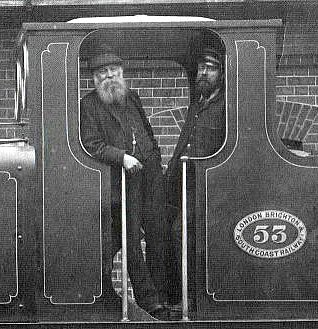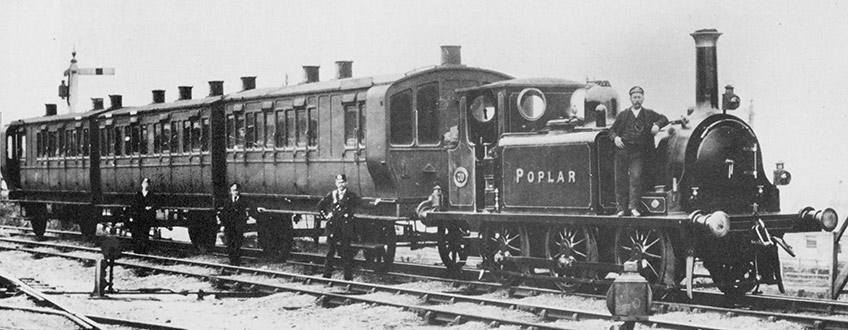
1869
Railway accidents on the
L.B.S.C.R.
from http://www.railwaysarchive.co.uk
Streatham Junction 3rd January 1869
no mention of Enginemen
SEE SUB PAGE
London Victoria 12th March 1869
Involving Driver Chris Barber, Fireman & Depot Unknown
SEE SUB PAGE
New Cross 23rd June 1869
no mention of Enginemen
SEE SUB PAGE
KEMP TOWN BRANCH
1869 - 1971
on the 31st December 1932 as a result of electrification of the Brighton main line, but
continued as a goods terminal until the 14th August 1971.
BASILICA FIELDS COLLECTION
THE OPENING OF THE EAST LONDON RAILWAYCOMMENCING ON THE 7th DECEMBER 1869, BETWEEN NEW CROSS & WAPPING
EXTRACTED & ADAPTED FROM THEBASILICA FIELDS WEBSITE

BASILICA FIELDS COLLECTION
The London, Brighton & South Coast Railway, was the first railway company to operate over the East London Railway, with services commencing on the 7th December 1869, between New Cross and Wapping.
The London & Croydon shared the route at the London end with the London & Greenwich, which itself became part of the South Eastern Railway in 1845 – both companies providing their own stations at New Cross, and both of which later became the terminating stations for many East London Railway trains. With the opening of the South London Line from 1866, Old Kent Road and later Peckham Rye would also become terminating stations for some LB&SCR hauled ELR trains.
Extending the line northwards under London Docks proved to be an herculean task, but L.B.&S.C.R. trains eventually ran into Liverpool Street from 1876. With the formation of the East London Railway Joint Committee (ELRJC) in 1882, which comprised the Metropolitan, Metropolitan & District, South Eastern Railway, London Chatham and Dover, the Great Eastern (from 1885) and the LB&SCR, the latter took responsibility for maintenance until handing over to the SER in 1885 (which had itself withdrawn trains over the line the previous year). From 1886, with the advent of GER services over the ELR, LB&SCR trains were cut back from Liverpool Street to Shoreditch, and the GER then took over LB&SCR services to Croydon.
With the opening of the ELR Extension (ELRE) and the New Tunnel, the LB&SCR provided passenger services over the Extended Widened Lines (EWL) through Basilica Fields to Bishopsgate (Liverpool Street), and for the first time provided a limited goods service to its recently opened small depots on the EWL.
By 1902, the LB&SCR was providing 64 of the 276 passenger trains every weekday over the ELR, but because the ELRJC initially failed to back the electrification plans for the Circle extending over the ELR, the Metropolitan and Metropolitan & District withdrew services over the line from the end of 1906, the upshot of which was that within five years the LB&SCR was providing over 100 trains daily to Shoreditch and back. The ELR was finally electrified in 1913.
By the early 1900s, passenger receipts over the EWL/ELRE were falling fast due to competition from the roads. Electric trams along Mile End Road, Burdett Road and Commercial Road had duplicated much of the EWL route, and electrification was deemed too great a financial risk, even for the determined Metropolitan Railway. The LB&SCR along with other members of the E.L..R.J.C. therefore continued to provide steam-hauled services until the line was closed during the Great War.

PHOTOGRAPHER UNKNOWN
New Cross Enginemen
Stroudley’s ’Terrier Tank Ashtead
London in the 1870s was a period of great expansion for the suburban railway. Most of the LB&SCR suburban services were first worked by ancient Craven tender engines which were highly unsuitable and caused severe congestion at the London termini as they queued to be turned. Their replacements, Stroudley’s A class tanks, had proved to be successful on inner suburban services on both the South London and East London Railways. Stroudley’s D class 0-4-2 tanks were introduced in 1873, were perfect for the task; they were more powerful than their 0-6-0T cousins. Their success resulted the building of 125 examples down the years to 1887, thirty one of which in the 1890s were based at New Cross for servicing trains north across the river via the ELR and SLR lines.
As suburban traffic continued to increase in capacity and weight, so the D1s began to take over even the inner suburban turns traditionally associated with the Terriers, which by the mid 1890s were rapidly being stripped of their condensing equipment and rusticated. The introduction of Billinton’s radial and bogie tanks in the 1890s had no more than a little effect on the class in the London district, but further introductions in the early 1900s prompted their rapid decline on outer suburban services and heralded the first withdrawals. The D1s remained in use on services over the East London Railway until electrification in 1913, and on the East London Railway Extension until 1915.
The D1 0-4-2Ts share turns with a Terrier on LB&SCR services through Basilica Fields via the East London Railway Extension and Extended Widened Lines. Number 299 New Cross, of that shed. Due to the frequency of trains over the East London Railway and East London Railway Extension it would make sense to incorporate at least another one of the 31 members of the class allocated to New Cross during the mid 1890s.
The East London line from New Cross to Shoreditch opened in 1876. eventually into
Liverpool Street station. From 1886 this service was cut back to Shoreditch. The Great Eastern Railway taking control of services into the terminus. The Great Eastern Railway also having control of all goods services through the Thames Tunnel from about 1880.
With the Extended Widened Lines feeding the New Thames Tunnel there was an increase in cross-river goods services, the London, Brighton & South Coast Railway, London, Chatham, & Dover Railway and South Eastern Railway all contributing and feeding into the north shore docklands and markets.
The L.B.&.S.C.R. had no part in goods workings over the East London Line via Wapping and Rotherhithe; those services were entirely under the jurisdiction of the Great Eastern which ran trains from and to the exchange sidings at New Cross. With the opening of the New Tunnel and a couple of small L.B.&S.C.R. depots north of the river, E1 tanks ran limited goods services via that route on to the Extended Widened Lines. New Cross had an allocation of twenty nine E1 tanks in the mid-1890s
BASILICA FIELDS COLLECTION
Railway accident on the
L.B.S.C.R.
from http://www.railwaysarchive.co.uk
Stewart’s Lane Junction 25th October 1869
no mention of Enginemen
SEE SUB PAGE

